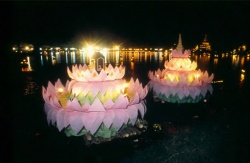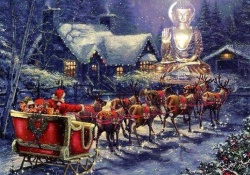Chengzong, Wenzong, Shundi
Chengzong, Wenzong, Shundi
Borijigin Temur (r. 1294-1307)
Chengzong
Chengzong was Kubilai Khan’s grandson and succeeded to the throne after his grandfather’s death when the Crown Prince (his father) Zhenjin passed away. Chengzong continued the legacy that his grandfather left behind continuing the patronage of Tibetan Buddhism. When requested by the Imperial Preceptor Gragspa ‘od zer]] to pardon Danyi Chenpo Zangpo Pal, a member of the Khon family, Chengzong, due to great respect for the Imperial preceptor appointed by his grandfather, Chengzong gave his consent. Chengzong appointed Rinchen Gyaltsen in 1305 as his Imperial Preceptor. However, Rinchen rgyal _ would serve only a short period of time before his untimely death. Chengzong offered 500 taels of gold, 1000 taels of silver 10 000 bolts of cloth and paper cash worth of 3000 silver ingots and built a stupa and temple in memory of him. Chengzong would then grant the title of Imperial Preceptor to Sang rgyal dpal who would eventually serve Chengzong, Wuzong and Renzong until is death in 1314.
Jijaghatu Toq-Temür (r. 1328-1329 and 1329-1332)
Wenzong
Wenzong ascended the throne in 1328 but was forced to abdicate a year later when his older brother, Qoshila Qutuqtu (Mingzong Emperor), returned from Central Asia with a powerful military force to reclaim the throne. However, after the mysterious death of Mingzong in 1329, Wenzong regained the throne and ruled briefly till 1332. During his reign, Wenzong granted the title of Imperial Preceptor to Rin chen bkra shis (who was the last imperial preceptor recorded in the Biographies of Eminent Buddhist Monks and Taoists) in 1328.
Toghan-Temür (r. 1333-1370)
Shundi
Shundi was the last emperor of the Yuan dynasty and continued to rule under the dynastic name even after being expelled from China by Ming forces. He was said to have received tantric teachings from the fourth Karmapa, Rol pa’i rdo rje who was invited to the Court during Huizong’s reign in China to help pacify and receive blessings from deities to help stabilize the problems that the Mongols were facing at the end of their rule. Shundi’s rule added controversy to the already unpopular Tibetan Buddhism among the Chinese officials. When erotic rites and practices were performed publicly in Shundi’s court and Chinese officials registered their disgust and shock at such acts of debauchery. Moreover, an offering of human hearts and livers to Mahakala was attested by the Imperial Preceptor during Shundi’s reign. The Chinese officials who did not understand the significance of such rituals in Tibetan Buddhist practices often protested against such extravagant displays of rituals which added to the hostility between the Chinese and Tibetan lamas.
Sources:
Herbert Franke, Tibetans in Yuan China: China among equals: the Middle Kingdom and its neighbor, 10th - 14th Centuries, UC, P, 1983
Drashi Rinchen, Tibetan Buddhism and the Yuan Royal Court, In Tibet Studies, pp 1-26.
Entry by ShiQi Wu, 2/11/07

